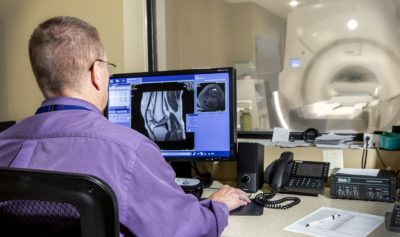Due to the continuous growth in technology, physicians have more advanced medical diagnostic devices and tools that make diagnosing orthopedic injuries easier and more efficient. When a patient is in need of orthopedic care, having the most advanced diagnostic testing and equipment can help the physician better evaluate the scans or films of the patient.
Identifying The Source of Your Pain
When a physician evaluates a patient’s scan or x-rays, they are searching for the cause of the patient’s pain. For those patients who are suffering from an orthopedic issue, their ligaments, cartilage, tendons, bones and muscles will be thoroughly evaluated to determine the underlying issue.
Types of diagnostic imaging used by our Atlanta Orthopedics
X-Ray
The X-ray is obtained by using a small amount of radiation to help produce a black and white image of a person’s body.
This test will help a physician determine whether or not a bone has been broken or dislocated. Even though this diagnostic imaging machine may be helpful in some cases, sometimes physicians need a more three dimensional approach to better diagnose the problem.
MRI
This type of scan, much like that of an X-ray takes pictures of the part of the body in need of treatment but rather than just looking for broken bones or dislocations, this magnetic resonance imaging machine helps identify if there are structural abnormalities or even degeneration. This image provides pictures of the surrounding tissues as well as the bones to give the physician the most accurate representation of the problem.
The plus side to having an MRI as opposed to an X-ray is that there is no exposure to radiation. This test however cannot be used on everyone, as those who have metal in their body from either a previous surgery or even a pacemaker cannot be candidates for this test as the MRI is magnetic and can cause internal injuries to those who have metal inside them.
Ultrasound
In order to get a better look at a small area, an ultrasound may be used to examine soft tissues and muscles and tendons which are not shown on an X-ray. This tool functions by sending sound waves off the tissues which creates a picture of the area of concern.
If a patient is suffering from knee pain, the ultrasound can be used to look at the tissue surrounding the knee and determine if there is tearing or other damage to the soft tissue. Another use for ultrasounds is to provide the physician with guidance when using injections for pain management for the joints. This tool can also provide images of tumors and calcified deposits on bones, and is radiation free as well.
Diagnostic imaging in Atlanta
If you suffer from an orthopedic injury, contact our AICA orthopedics team and we will provide you with some of the most efficient diagnostic imaging in Atlanta. Our team of doctors will work with you to create the best individualized treatment plan that fits your needs. Call us today at (404) 855-2141.


